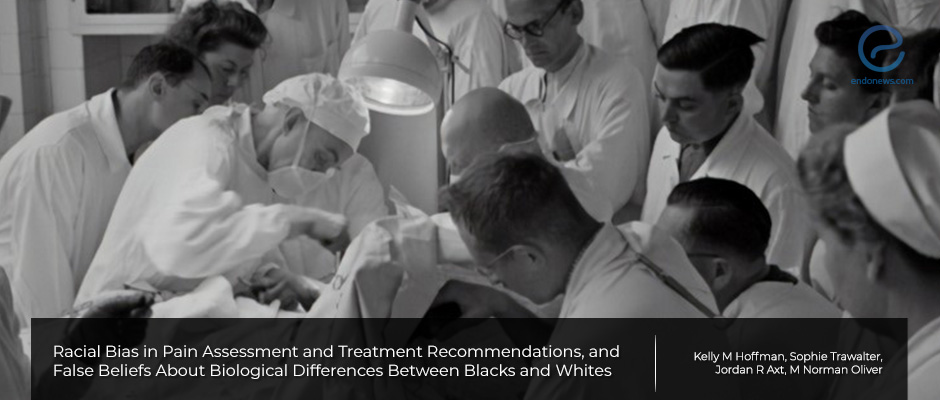Racial Bias in Pain Assessment and Treatment Recommendations
Jun 19, 2020
False beliefs about biological differences between blacks and whites are associated with racial bias in pain perception and inadequate treatment recommendations for black patients’ pain.
Key Points
Highlights
- This study demonstrates that false beliefs about biological differences between blacks and whites are associated with the perception that black people feel less pain than do white people resulting in inadequate treatment recommendations for black patients’ pain.
Importance
- Evidence has revealed that racial disparities in pain management exist.
- Relative to white patients, black patients are less likely to be given pain medications and, if given pain medications, they receive lower quantities.
- This is the first study to show that racial bias in pain assessment is associated with racial bias in the accuracy of pain treatment recommendations.
What’s Done Here
- Studies show that many laypeople, scientists, and scholars continue to falsely believe that the black body is biologically and fundamentally different from the white body (e.g. that blacks have thicker skin than do white people or that black people’s blood coagulates more quickly than white people’s blood).
- This study examined whether false beliefs about biological differences are associated with racial bias in pain perception and treatment recommendations.
Key Results
- Many white adults without medical training and white medical students and residents endorse false beliefs about biological differences between blacks and whites, and these false beliefs are related to racial bias in pain perception.
- Furthermore, white medical students and residents who endorsed false beliefs showed racial bias in the accuracy of their pain treatment recommendations.
Limitations
- The study was limited to assessing the beliefs and racial bias of medical students and residents, rather than medical personnel in more advanced stages of their career.
- Survey methods were used to assess medical students’ and residents’ beliefs and racial bias. Future research is required to understand whether these beliefs have consequences for pain assessment and treatment in real medical contexts.
Lay Summary
This study, published by Hoffmann et al. in the April 2016 issue of Proceedings of the National Academy of Sciences, found that false beliefs about biological differences between blacks and whites are associated with the perception that black people feel less pain than do white people resulting in inadequate treatment recommendations for black patients’ pain.
As some studies suggest that racial bias in pain treatment may result from racial bias in perceptions of others’ pain, the researchers in this study investigated whether racial bias in pain assessment is associated with racial bias in the accuracy of pain treatment recommendations. Two parallel studies were conducted as part of this larger study. The first one included 92 individuals without medical training and asked participants to report the amount of pain they would feel across 18 scenarios (e.g., “I slam my hand in a car door”; scale: 1 = not painful, 2 =somewhat painful, 3 = moderately painful, 4 = extremely painful). These participants were then randomly assigned to rate the pain of a gender-matched black or white target across the same scenarios. Participants also rated the extent to which 15 biological differences between blacks and whites are true or untrue on a six-point scale (e.g. that blacks have thicker skin than do white people or that black people’s blood coagulates more quickly than white people’s blood).
The second study included 222 medical students and residents. Participants were asked to read two mock medical cases about a black and a white patient and made pain ratings (scale: 0 = no pain to 10 = worst possible pain) and medication recommendations (dummy coded for accuracy: 1 =accurate, 0 = inaccurate) for each. They also completed the same measure of beliefs about biological differences between blacks and whites as in study 1.
The studies revealed that many white adults without medical training and many white medical students and residents endorse beliefs, “many of which are false and even fantastical in nature”, about biological differences between blacks and whites, and these false beliefs are related to racial bias in pain perception. Briefly, participants who endorsed more false beliefs rated the black patients as feeling less pain than white patients. Furthermore, white medical students and residents who endorsed false beliefs showed racial bias in the accuracy of their pain treatment recommendations. Participants who endorsed more of these beliefs reported that a black (vs. white) target patient would feel less pain and they were less accurate in their treatment recommendations for the black (vs. white) patient. Participants who did not endorse or endorsed less of these false beliefs reported that a white (vs. black) patient would feel less pain. However, these medical students and residents did not exhibit racial bias in treatment recommendations.
The authors further noted that “future work will need to test whether white and nonwhite medical personnel in more advanced stages of their career also hold beliefs about biological differences between blacks and whites, and if so, whether these beliefs have consequences for pain assessment and treatment in real medical contexts."
Research Source: https://pubmed.ncbi.nlm.nih.gov/27044069/
Pain assessment pain perception racial bias medical students residents blacks belief false-belief physician scholar disparitiy

